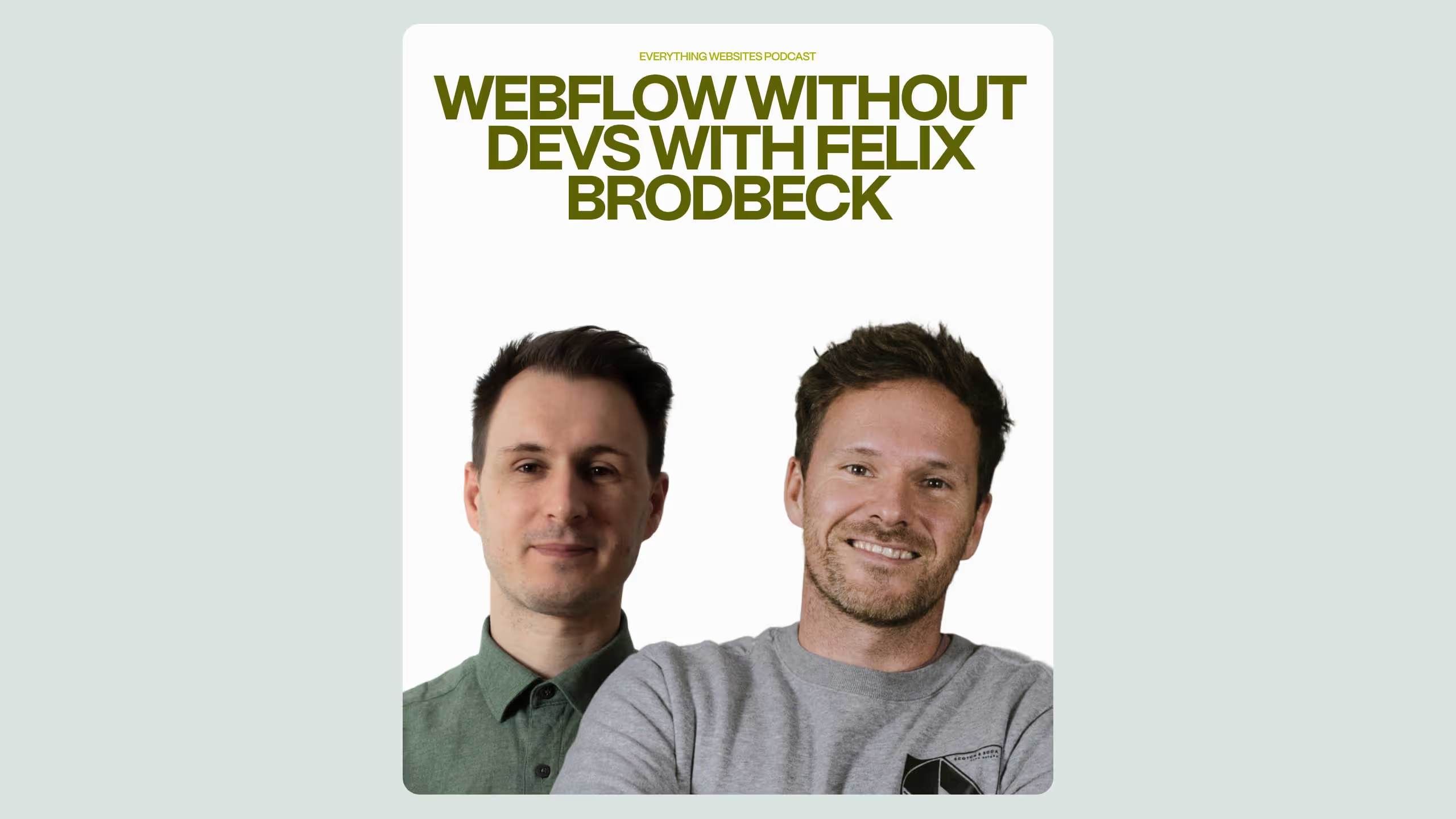Webflow Without Devs: A Team Playbook

The episode with Felix Brodbeck reveals that “Webflow Without Devs” isn’t about excluding engineers, it’s about enabling faster, safer marketing execution. By defining clear roles, enforcing permissions, and building a flexible component system, teams can publish confidently in Build mode while preserving performance, SEO, and accessibility.
The key insight: speed requires structure. Run your website like a product, measure, document, and iterate, and your team gains the autonomy of “no-dev” workflows with the stability of enterprise-grade governance.
Webflow without devs: A team playbook 2025 with Felix Brodbeck
If you’ve ever thought “we could ship this page today if only we didn’t need to wait for a developer,” this guide is for you. In my chat with Felix of DesignBase Studio, whose YouTube tutorials have demystified Webflow for thousands, we broke down what it really takes to run Webflow Without Devs: A Team Playbook inside a marketing organization. The goal isn’t to sideline engineers. It’s to unblock marketers, content teams, and designers so they can build, test, and iterate safely, while preserving brand consistency, accessibility, performance, and analytics integrity.
In the pages below, you’ll get a field-tested operating model for Webflow Without Devs: A Team Playbook, including roles, permissions, component strategy, naming conventions, onboarding and training checklists, editor best practices, page-building workflows, experiment cadences, and a responsive decision table you can paste directly into your CMS. We’ll also point you to internal resources, like our Webflow services and growth subscriptions, so you can turn today’s ideas into tomorrow’s revenue.
Why “no dev” does not mean “no discipline”
Running Webflow Without Devs: A Team Playbook is about independence with guardrails. Webflow hands you immense flexibility, but flexibility always arrives with complexity. When non-technical teammates can build landing pages, rename components, or swap global classes, you either have a process…or you have chaos.
Here’s the mindset that works:
- Think in systems, not pages. Components are your source of truth. Pages simply orchestrate components.
- Govern with roles and permissions. Most of your team should live in Build (Editor) mode. A small, trained group holds Designer seats.
- Measure, then merge. A/B test variants, merge winners into the library, and retire losers. Evidence beats opinions.
- Teach the basics. Even in Webflow Without Devs: A Team Playbook, teammates should know the essentials of HTML structure, CSS classes, and CMS collections, even if they never touch code.
The essential team structure
To run Webflow Without Devs: A Team Playbook at scale, keep roles clear and responsibilities narrow.
Marketing Owner (one person)
- Prioritizes pages and experiments
- Approves copy, messaging, and conversion goals
- Owns the monthly roadmap and launch calendar
Content Editors (several people)
- Update CMS content, write posts, swap imagery
- Build simple landing pages with existing components
- Ensure alt text and SEO fields are filled
Design/Built-Mode Champions (one to two people)
- Power users in Build mode, create pages from component library
- Run pre-publish checks (links, metadata, schema consistency)
- File requests for new components
Designer Seat Holders (one to two people)
- Maintain the component library, classes, and tokens
- Approve global changes (navigation, footers, CTAs)
- Version components and update documentation
Analytics & Experiment Lead (one person)
- Sets up A/B tests and event tracking
- Monitors Core Web Vitals and on-page behavior
- Socializes learnings and merges winners
You may rotate these responsibilities in smaller teams. What matters is that not everyone is in the Designer; that’s how Webflow Without Devs: A Team Playbook stays fast and safe.
Tool access & permissions (the golden rule)
A core lesson from Felix: the easiest way to break a site is to let everyone into Designer. In Webflow Without Devs: A Team Playbook, default everyone to Build (Editor) mode, and strictly limit Designer seats. When teammates need to alter global navs, footers, or CTA sections, they file a quick request and a Designer seat holder updates the component. This slows down “one click” changes by minutes, but it prevents weeks of clean-up later.
Component-first: your runway to speed
Your editors move fast only when components are clear, flexible, and documented. This is where Webflow Without Devs: A Team Playbook shines.
Build these first:
- Hero (headline, subhead, media slot, CTA variations)
- Proof band (logos, quotes, ratings)
- Feature grid (icons, headings, supporting text)
- Long-form content layout (H tags, pull quotes, image treatments)
- Pricing (tiers, feature bullets, tooltips, FAQ)
- Conversion footer/CTA slices (newsletter, trial, demo)
Make them adaptable via properties:
- Size and spacing presets
- Media toggles (image, video, Lottie)
- Theme (light/dark/brand accents)
- Layout options (1–4 columns, left/right media)
- Optional elements (badges, sub-CTAs, legal notes)
Component flexibility in Designer means page velocity in Build mode. That is the engine of Webflow Without Devs: A Team Playbook.
Naming conventions that survive growth
A common failure mode is “mystery classes.” Adopt a human-readable system across layouts, components, and utilities.
- Utilities:
u-mt-24,u-flex,u-center - Layout:
l-container,l-grid-3,l-stack-32 - Components:
c-hero,c-hero__title,c-hero--alt,c-card,c-pricing__tier - State:
is-active,is-hidden
Pick a convention and stick to it. Document with a one-page guide and a Loom walkthrough. In Webflow Without Devs: A Team Playbook, predictable names equal predictable changes.
CMS modeling that empowers editors
For a team-operated site, model content for how your editors think:
Collections to consider
- Blog posts (with author and topic references)
- Case studies (industry, solution tags, outcomes)
- Landing pages (campaign, audience, offer)
- Integrations (logo, partner link, category)
- FAQs (topic, snippet, schema toggle)
Fields that matter
- SEO: title, meta description, OG image
- Accessibility: alt text, media captions
- Experiment flags:
variant-label,test-group - Schema: booleans for FAQ/HowTo/Product where relevant
With this structure, non-developers can publish like pros. That’s the heart of Webflow Without Devs: A Team Playbook.
Onboarding your team (and avoiding confusion)
Felix called out how confusing first-time setup can be. Use this simple onboarding pattern:
- Create the workspace (no plan purchase yet).
- Invite roles (Editor vs Designer), and explain why.
- Loom library of 5-minute clips:
- Build mode vs Designer
- How to update CMS items (publish vs draft vs staged updates)
- How to build a page from components
- What not to touch (global classes, utility classes)
- Image optimization and alt text
- Checklists: pre-publish QA, accessibility, and SEO.
- One live co-building session to cement confidence.
Reducing first-week friction is how Webflow Without Devs: A Team Playbook wins hearts, and prevents “I pressed one thing and broke everything.”
Editor best practices (non-technical teammates)
- Work from components. Don’t hand-tweak per page if a component can carry the change.
- Respect global elements. Nav, footer, and global CTAs change in Designer.
- Use drafts and staged publishing wisely. If it’s not live, check your publish state.
- Right-size images. Aim for < 200KB hero images when possible, use WebP, and set alt text.
- Avoid editing a class you don’t recognize. If a style has “u-”, “l-”, or
c-in the name, ask before changing.
These five habits keep Webflow Without Devs: A Team Playbook humming.
A monthly operating rhythm
Run a simple cadence to keep momentum and clarity:
Week 1: Plan
- Review last month’s experiments and traffic
- Prioritize the next two landing pages
- Slot one accessibility/performance improvement
Week 2–3: Build & test
- Ship pages from components in Build mode
- Launch one A/B test (headline, CTA, or proof order)
- Monitor errors and Core Web Vitals
Week 4: Learn & merge
- Socialize results in a 30-minute review
- Merge winners into the component library
- Update documentation and archiving
Repeat. The repetition builds confidence, and proof. That’s Webflow Without Devs: A Team Playbook in action.
Responsive decision table
Use this to decide who should do what,and where. It’s mobile-friendly and accessible.
Common mistakes (and how to avoid them)
- Editing global classes without realizing it.
Fix: label utilities and globals clearly; train editors to avoid class changes in Build mode. - Images that are too heavy or too small.
Fix: export WebP/JPEG at appropriate sizes (hero ~1600–2000px wide), compress under ~200KB when possible, always set alt text. - Publishing confusion in CMS.
Fix: teach the difference between “Save,” “Draft,” and “Publish,” and set a simple staging practice for high-stakes content. - Too many Designer seats.
Fix: default to Build access; require a quick request for global component edits. - One-off page tweaks instead of component updates.
Fix: if three pages need the same fix, it’s a component problem, change it once.
This is day-to-day hygiene for Webflow Without Devs: A Team Playbook.
A fast workflow for new landing pages
- Brief (15 minutes): goal, audience, traffic source, single CTA, one proof element.
- Outline (20 minutes): hero → proof → problem → solution → features → CTA → FAQ.
- Assemble (45–60 minutes): Build mode only, from components.
- QA (20 minutes): links, headings (H1–H3), alt text, mobile check.
- Track (15 minutes): add events and verify in preview.
- Publish & test: launch variant B with a single change (headline or CTA).
- Review (next week): fold winner into the library.
This is how Webflow Without Devs: A Team Playbook turns ideas into measurable outcomes, fast.
Training plan: from zero to confident in two weeks
Day 1–2: Webflow University essentials (structure, classes, CMS), plus 3 Looms tailored to your site.
Day 3–4: Guided Build-mode session: create a landing page from components.
Day 5: SEO & accessibility basics; image optimization workshop.
Day 6: CMS mastery: posts, case studies, collections, staged publishes.
Day 7: A/B testing setup and result reading.
Day 8–10: Shadow a Designer seat holder updating a global component; learn review and versioning.
Day 11–14: Two solo page builds with QA sign-off.
At the end, your team can truly run Webflow Without Devs: A Team Playbook without panic.
When you should involve a developer
Even with Webflow Without Devs: A Team Playbook, engineers are invaluable for:
- Advanced integrations (complex CRM logic, data syncs, custom APIs)
- Performance profiling beyond the basics
- Complex animations or bespoke interactions
- Security reviews and privacy compliance
“No dev” doesn’t mean “no engineering.” It means you reserve developer time for leverage, not for routine page work.
Closing: make this your team playbook
Felix’s biggest lesson mirrors what we see daily: Webflow empowers non-developers to ship, but only if you treat the site like a product. Name things clearly. Build a component system. Limit Designer access. Train your editors. Measure outcomes. Do that, and Webflow Without Devs: A Team Playbook becomes an unfair advantage, faster launches, cleaner governance, and a team that actually enjoys publishing.
If you want a jumpstart, component library, training, experiment rhythm, we’re ready to help. Explore our Webflow services.
.svg)
.svg)




.svg)
.svg)


